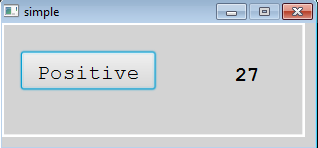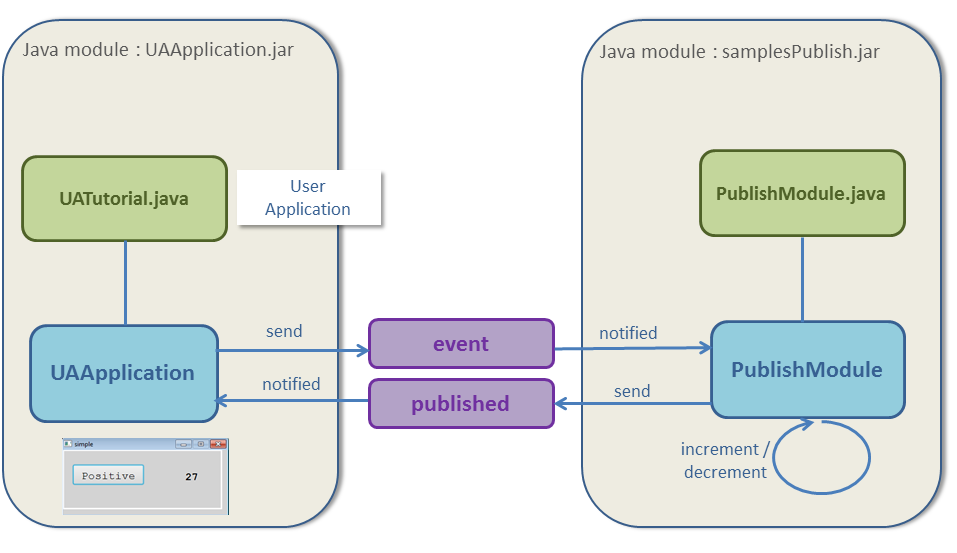Home
Categories
Dictionary
Glossary
Download
Project Details
Changes Log
What Links Here
FAQ
License
UA tutorial
1 Overview
1.1 First tutorial architecture
1.2 UA Application tutorial architecture
2 Modifying the configuration
3 Specifying the Definition File
4 Developing the User Application
4.1 Using the Functional UA runtime API
5 Setting the User Application configuration
6 See also
1.1 First tutorial architecture
1.2 UA Application tutorial architecture
2 Modifying the configuration
3 Specifying the Definition File
4 Developing the User Application
4.1 Using the Functional UA runtime API
5 Setting the User Application configuration
6 See also
In this tutorial, we will learn about developing a UA (User Application). We will reuse the first tutorial, and replace the
Note that a UA application module is just an empty shell which is able to wire the notifications and invocations of the services to one or several ARINC 661 Clients. We will then need to develop the UA Client which will replace the
And two applications:


The new architecture is:

We will also specify the Windowing Configuration (in our case, we will only have one Window):

We will define our UA configuration using the uaImpl and uaPath properties:
eventAppli with a User application.Note that a UA application module is just an empty shell which is able to wire the notifications and invocations of the services to one or several ARINC 661 Clients. We will then need to develop the UA Client which will replace the
eventAppli of the first tutorial.
Overview
First tutorial architecture
The first tutorial defined two services:- One Service published a value
- Another Service published the state of a toggle button in case of a click event
And two applications:
- The first
PublishModulehad no graphical interface and: - Incremented or decremented the value
- Published cyclically the value
- Listened to the toggle event to set if the value should increment or decrement
- The second
EventModulehad a graphical interface and: - Subscribed to the published value and show this value
- Showed a toggle and sends an event when the user clicks on this toggle

UA Application tutorial architecture
We will replace theEventModule module by a User Application. It will be embedded in a built-in UA application. This module will:- Subscribe to the published value and show this value on an ARINC 661 Layer
- Show a ToggleButton on the ARINC 661 Layer and sends an event when the user clicks on this toggle

The new architecture is:

Modifying the configuration
We won't modify thetypes.xml or the services.xml configuration files, because we will use the same services as in the first tutorial. But we will replace the eventAppli by a User Application:<applications> <application name="uaappli"> <deployment> <lib url="UAApplication.jar" /> </deployment> <modules> <module name="uaappli"> <interfaces> <eventSend service="event" attach="attach"/> <subscribe service="published" /> </interfaces> </module> </modules> </application> <application name="publishAppli" "> <modules> <module name="PublishModule" > <implementation path="org.da.samples.protoframework.publish.PublishModule" > <initEntryPoint method="init" /> <defaultReceiveEntryPoint method="subscribe" /> <defaultSendEntryPoint method="publish" /> </implementation> <interfaces> <eventReceived service="event"/> <cyclic service="published" frequency="200ms" attach="attach"/> </interfaces> </module> </modules> </application> </applications>
Specifying the Definition File
The Definition File will contain:- One ToggleButton
- One Label
We will also specify the Windowing Configuration (in our case, we will only have one Window):
<cockpit> <DFFiles> <df path="tutorial.xml" /> </DFFiles> <windows> <windowDef name="Window" width="8000" height="3000" x="0" y="0" /> </windows> <configs border="255,255,255" borderWidth="3"> <display id="1" name="simple" width="8000" height="3000" defaultLayout="1"> <layout name="layout" id="1"> <window name="Window"> <layer layerID="1" /> </window> </layout> </display> </configs> </cockpit>Now we will specify the ARINC 661 configuration for both the ARINC 661 Client and the ARINC 661 Server:
graphics=DefGraphics.xml ui=LookAndFeel.xml pictures=DefPictures.xml lf=JavaFX supplement=6 warnForUndefAttrs=false serverInputPort=8080 serverOutputPort=8081 serverInputSize=50000 serverOutputSize=200 server.autoVisible=true logServerArea=true windowManager=windows server.windows=tutorialWindow.xml server.computeLayerSize=false server.menus=true server.uiCombo=true maximumQueueSize=50The result will be:

Developing the User Application
Now we will develop our User Application:- The
init()method will be used to add the listener which will listen to the click on the ToggleButton and invoke the event Service - The
subscribe(ServiceInstance)method will be fired when the User Application module is notified from thepublishService
public class UATutorial extends AbstractFunctionalUA { private static final int LAYER = 1; private static final int TOGGLE_BUTTON = 1; private static final int LABEL = 2; private SendEventServiceInstance eventService = null; public UATutorial() { } public void init() { this.eventService = (SendEventServiceInstance) module.getService("event"); api.addWidgetEventListener(LAYER, TOGGLE_BUTTON, new ARINCEventListener() { public void eventReceived(ARINCEvent evt) { WidgetEvent widgetEvt = (WidgetEvent) evt; try { boolean isSelected = ((Boolean) widgetEvt.getValues().get(0)); eventService.setDataBooleanValue("event", isSelected); eventService.invoke(); } catch (ARINCRuntimeException ex) { logger.error(module, ex.getMessage()); } } }); } public void subscribe(ServiceInstance service) { if (hasChanged("value")) { String value = getStringValue("value"); api.setWidgetParameter(LAYER, LABEL, ARINC661.A661_STRING, value); api.sendAll(); } } }
Using the Functional UA runtime API
It is possible to use the Functional UA runtime API rather than the built-inapi in the UA. In our example:public class UATutorial extends AbstractFunctionalUA { ... public void subscribe(ServiceInstance service) { if (hasChanged("value")) { String value = getStringValue("value"); runtimeAPIHelper.setA661WidgetParameter(LAYER, LABEL, ARINC661.A661_STRING, value); runtimeAPIHelper.sendAllA661BufferContent(); } } }We can use the parrameter namer rather than its ID:
public class UATutorial extends AbstractFunctionalUA { ... public void subscribe(ServiceInstance service) { if (hasChanged("value")) { String value = getStringValue("value"); runtimeAPIHelper.setA661WidgetParameter(LAYER, LABEL, "LabelString", value); runtimeAPIHelper.sendAllA661BufferContent(); } } }or even with using the names of the Layer and the Widget:
public class UATutorial extends AbstractFunctionalUA { ... public void subscribe(ServiceInstance service) { if (hasChanged("value")) { String value = getStringValue("value"); runtimeAPIHelper.setA661WidgetParameterFromName("MyLayer", "label", "LabelString", value); runtimeAPIHelper.sendAllA661BufferContent(); } } }
Setting the User Application configuration
Now we will need to specify the properties of the UA application.We will define our UA configuration using the uaImpl and uaPath properties:
<properties> <application name="uaappli" > <module name="uaappli" > <moduleProperty key="uaImpl" value="UATutorial.jar" /> <moduleProperty key="uaPath" value="org.da.protoframework.tutorial.uaappli.UATutorial" /> <moduleProperty key="a661Config" value="a661/tutorial.properties" /> <moduleProperty key="includeServer" value="true" /> </module> </application> </properties>
See also
- Built-in Applications: This article present the built-in Applications distributed with the framework
- UA application: The built-in UA application allows to execute an ARINC 661 Client
- Developing a UA: This article explains how to develop a User Application
×
![]()
Categories: builtin-applis | tutorials | uaappli